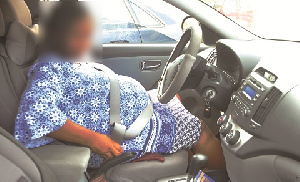Opinions of Tuesday, 21 June 2016
Columnist: Seth J. Bokpe
It is safe to use a seat belt during pregnancy but…
Akua is fixated on seatbelts. She constantly engages in a verbal brawl with her husband over his reluctance to wear his seatbelt anytime they enter their vehicle.
But now Akua faces a dilemma. She is six months pregnant and is restless about the safety of her baby when she wears a seat belt.
She has read countless articles online that seem reassuring but she has decided to shelve the idea of driving entirely in order not to lose her first pregnancy, although her doctor has assured her that she is safe.
While her fears are genuine, experts say there is no cause for alarm.
Research has repeatedly shown that the best way for pregnant women to protect their growing baby is to protect themselves by wearing a properly positioned safety belt each and every time they are in a car or truck.
To avoid injuring themselves and their baby, the seat belt must be properly fastened.
A gynaecologist at the Ridge Hospital, Dr Joseph Lawerter, said: “There is no risk to a pregnant woman wearing seat belt because there is fluid around the baby that serves as shock absorber.”
According to him, during sleep, pregnant women do exert some form of pressure on the pregnancy but wake up fine.
“Unless the pregnancy has developed a complication which you want to avoid, we advise that you shouldn’t go to work and don’t do any excessive activity but with a normal pregnancy where mother and baby are well, they have no problem when they wear seat belt,” he said.
On driving, he said pregnant women could drive but if at any point in time they felt uncomfortable, then it was advisable to take it easy.
“When you are driving, what you need is concentration of the mind, your hands and feet to move you back and forth. It is just that sometimes on our roads, people might misbehave and it raises the blood pressure of the driving pregnant woman but for safety, there is no problem,” he said.
Beware of the danger
But according to a research reported by the United Kingdom portal, Mail Online, there were millions of pregnant women who could be putting themselves and their unborn babies' lives at risk by not wearing seatbelts correctly.
More than 85 per cent of pregnant car users questioned were not following medical guidelines on how to position their seatbelts, with some not wearing safety belts at all.
The research, which was carried out at Loughborough University, will now be used to inform car designers about the needs of pregnant women.
Of the 400 people questioned as part of the study, 87 per cent were not following recommended guidelines on how to wear their seatbelts and many were holding the strap away from the body for comfort.
The principal investigator of the project, Dr Serpil Acar, said: "Recommended guidelines specify that seatbelts should be worn throughout pregnancy with the lap strap across the hips and fitting under the bump while the diagonal strap is placed between the breasts and around the bump.
"But our research reveals that most pregnant women are not aware of these guidelines or, in some cases find it impractical to follow the guidelines.”
"Some pregnant women experience discomfort, they pull and hold the seatbelt away from their bodies and some do not even wear the seatbelt at all.”
"Pregnant car users who improvise to increase comfort might be risking their lives and those of their unborn babies," Dr Acar said.
One pregnant woman who does not joke with seat belt is Ms Ama Baafi.
“Seatbelt is safe for everybody whether you are pregnant or not. It is the only way you are protected from accident on the road.
“There was a day I was going to work and at an intersection, the driver behind hit the back of my car. But for the fact that I was wearing seatbelt while I was pregnant, it would have been a disastrous situation. Seat belt is good for everybody. I don’t feel uncomfortable because I don’t put it on my tummy and it should not be too tight,” she said.
How to wear
A properly worn seat belt is one that secures the lap belt below the belly, low and snug on the hip bones.
The babycentre.com advises that pregnant women should never wear the belt across or above their belly.
During a crash, the sudden jolt from a belt in this position could cause the placenta to tear away from the uterus or cause other injuries.
“If you're wearing a heavy sweater that makes the seat belt slide up on your belly, consider removing your outerwear once it's warm inside the car,” the website advised.
Always use the shoulder belt, too, which should fit snugly between your breasts. If the shoulder belt cuts across your neck, reposition your seat or the belt so it fits better. Do not place the shoulder belt under your arm or behind your back.
According to experts, air bags offer additional protection, so make sure yours are turned on. However, air bags do not replace the need to wear your seat belt. (In fact, an air bag can be dangerous if it opens and you're not securely buckled up.)
When you're driving, adjust the front seat so it's as far away as possible from the steering wheel and dashboard while still allowing you to reach the pedals comfortably. If your steering wheel is adjustable, aim it up and away from your stomach. That way, the air bag will deploy toward your chest, not your belly.
Entertainment










